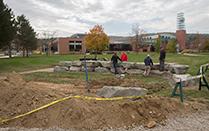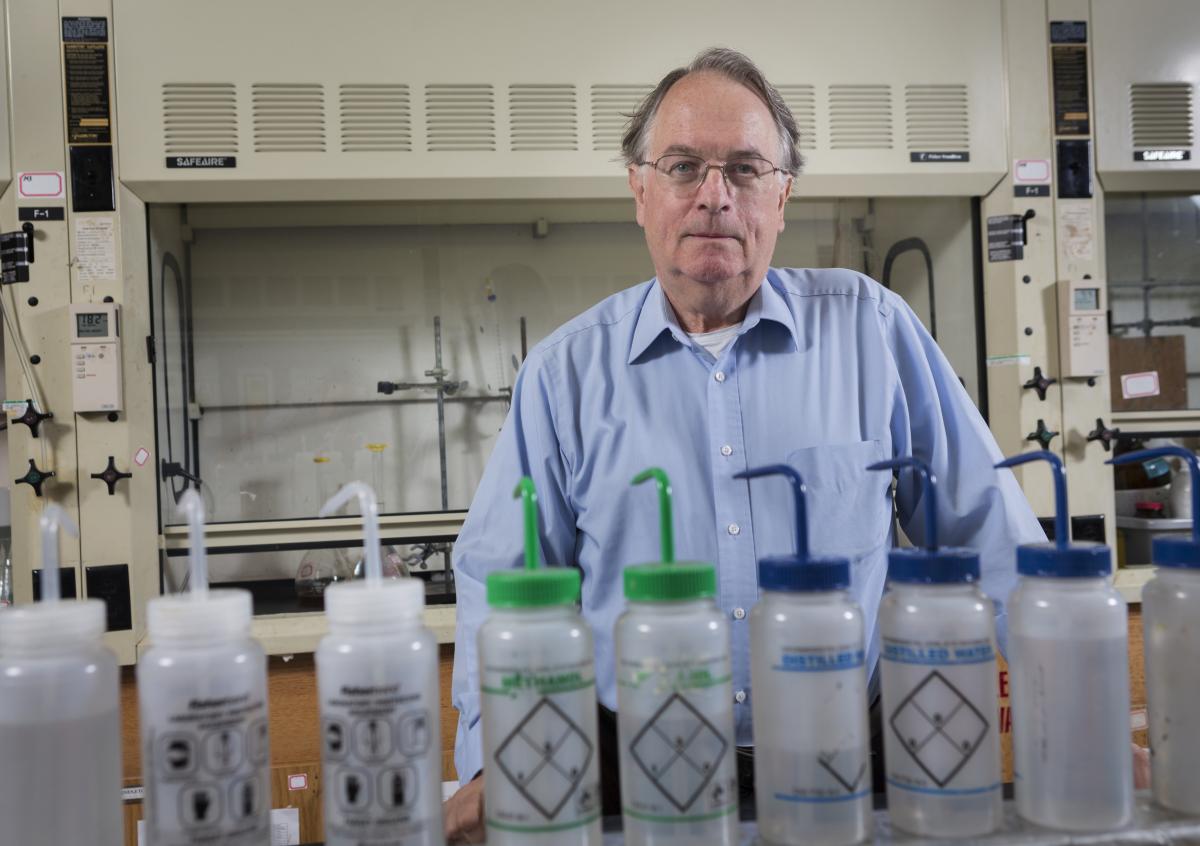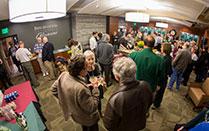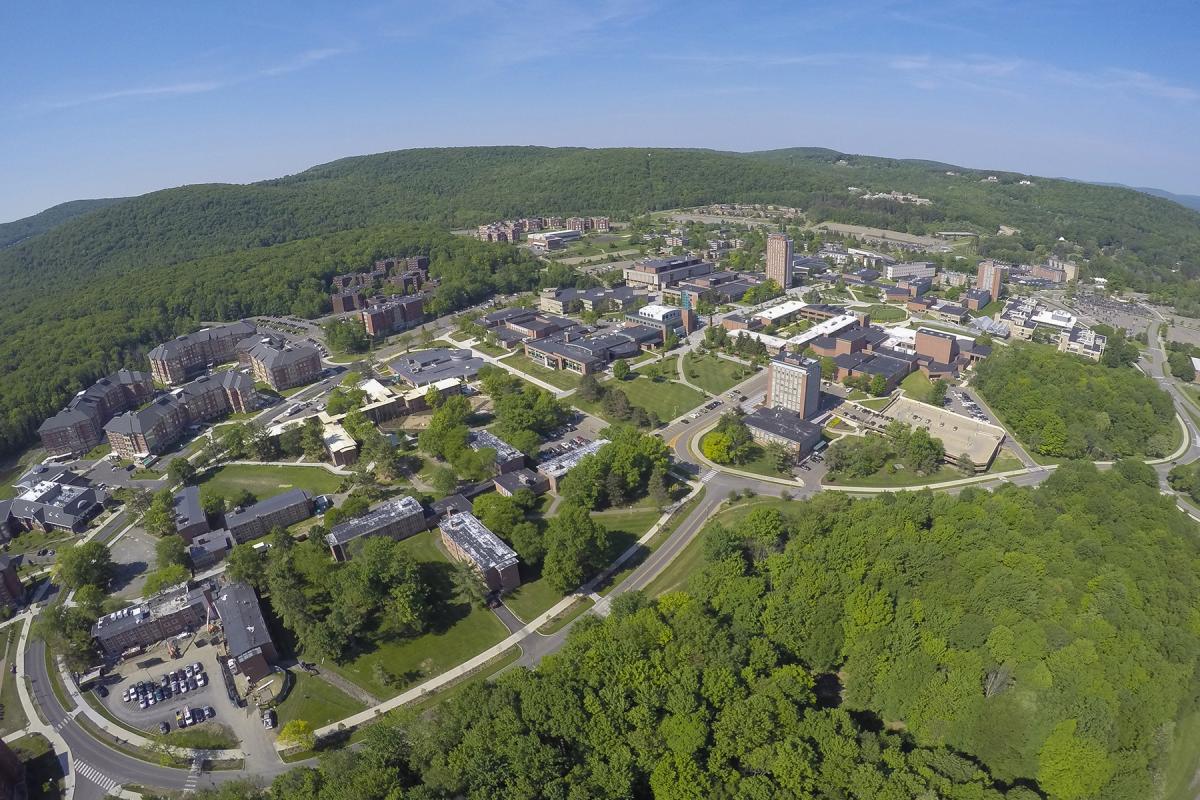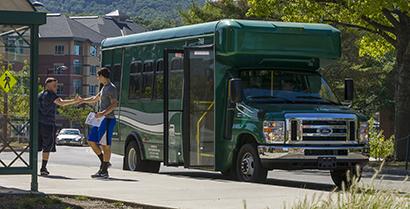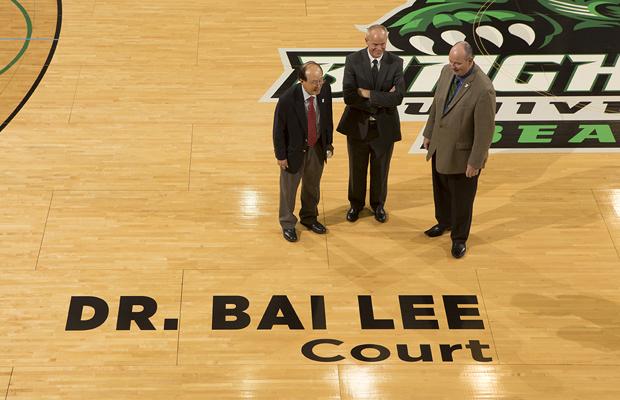Binghamton University President Harvey Stenger's Road Map Quarterly Report - December 31, 2015
As we wound up the fall 2015 semester, Binghamton University and the communities around us received excellent news. The Southern Tier has been identified as a “Best Plan Awardee” as part of New York state’s Upstate Revitalization Initiative (URI). The region will be receiving $500 million over five years to address key economic development challenges. The University has proposed a number of projects as part of the region’s plan, so the win will have a significant impact on the University.
As co-chair of the Regional Economic Development Council that developed the URI proposal, I believe the Council’s success was the product of many different organizations working with a unity of purpose to achieve a great result. I have noticed that this same outlook motivates much of what we do on campus. Compared to most other campuses, I think Binghamton is distinguished by its flexibility, agility, and ability to work across divisions and departments. We succeed best when faculty and staff work to approach problems from multiple perspectives — whether they are trying to foster engagement with alumni and other supporters, develop cutting-edge research and scholarship that addresses society’s concerns, or working to increase diversity and inclusion on campus.
Upstate Revitalization Initiative and community engagement
Binghamton University is among many of the region’s organizations that will benefit from the Southern Tier being named a “Best Plan Awardee in New York state’s Upstate Revitalization Initiative (URI) competition. As a top award winner, the region will receive $500 million in economic development funding over the next five years. A centerpiece of the plan was the establishment of three “Innovation districts” or “Idistricts” in the Greater Binghamton region, focusing on high-technology manufacturing.
The Southern Tier Regional Economic Development Council (STREDC), of which I am co-chair, submitted its URI proposal in early October and was recognized as a winner by Gov. Andrew Cuomo at a special ceremony on Dec. 10.
Several proposals in the REDC’s plan will directly or indirectly impact the University. These include a plan to rehabilitate 48 Corliss Ave. in Johnson City, to serve as a new home for the Decker School of Nursing. This will allow the nursing school to colocate with the already funded School of Pharmacy and Pharmaceutical Sciences, a key step for the initiative to establish The Health Sciences and Technology Innovation Park at the center of the Johnson City iDistrict and part of the overarching strategy to build the Greater Binghamton Innovation Ecosystem.
Also included in the URI plan is the development of a battery dry room for testing and battery research conducted by Distinguished Professor M. Stanley Whittingham and his NorthEast Center for Chemical Energy Storage team. This will facilitate the team’s research in maximizing battery life and efficiency. A battery dry room is an essential component for manufacturers to build and test systems.
The plan also provides funding to expand both the University-driven Flexible Printed Electronics Technology Center and an Industrial 3D Printing Center for Product Prototyping and Commercialization. These two projects, which will be colocated at the Huron Campus in Endicott, are both part of the Endicott Advanced Manufacturing iDistrict. The Endicott iDistrict will be driven by these two centers and major anchors such as BAE Systems and i3 Electronics, and will establish Greater Binghamton as the preeminent place for flexible hybrid electronics and manufacturing with thin, flexible-glass technology and industrialization of 3D printing processes.
Funding to establish secure electronics and advanced manufacturing projects through partnerships with Lockheed Martin and other firms and research organizations is also part of the plan. This initiative will capitalize on Binghamton University’s strong record of research in electronics hardware to develop cybersecurity and trusted manufacturing capabilities.
There are a number of other projects that will have an indirect impact on the University. These include a Route 434 Greenway/Bike Trail that will connect with the University, the development of 7 Hawley St., Binghamton into a mixed-use parking, residential and retail/commercial space, and the Lackawanna Train Station Revitalization in the Binghamton iDistrict; the Century Sunrise mixed-use development and Goodwill Theatre Phase 2 in the Johnson City Health and Cultural iDistrict; a Downtown Endicott Revitalization Plan in the Endicott Advanced Manufacturing iDistrict; and a SUNY Broome Specialized Technician Training Program.
I want to thank everyone in the University community who played a role in developing the proposal. I believe that we were successful because we put together a very strong plan that addresses the key economic development challenges facing the region, with emphasis on industry and manufacturing, agriculture, transportation and tourism. It was an integrated approach that leverages our regional strengths from Corning, Ithaca and the Greater Binghamton region.
But the greatest strength of our proposal was that we have a number of very good initiatives ready to move forward in areas ranging from healthcare to alternative energy. The URI award is a win-win for the region and the state, and we will quickly see the impact of these investments helping transform Binghamton, Johnson City, and Endicott.
All in all, the announcement was a historic day for Upstate New York, and I feel that 20 years from now people will look at this win as the point when the Southern Tier began its comeback.
Binghamton University’s engagement in the community extends beyond economic development, however; two Binghamton students won elected office in November’s elections. Sophomore political science major Conrad Taylor and political science doctoral candidate Giovanni Scaringi both won seats on the Binghamton City Council, with each crediting their professors for inspiring and supporting them. Key to their success were broad coalitions of Binghamton students who reside in their electoral districts, though both emphasized their commitment to constituent services as the reason for their victory. Their elections are testimony to the fact that Binghamton students really are members of the broader community.
Homecoming and Family Weekend
The University also held two annual events that celebrate the links between the University and its students and alumni. In early October, the University held its Homecoming, drawing more than 800 alumni back to campus. There were a number of special events that highlighted the achievements of our alumni and offered the campus a chance to reconnect with them. Perhaps the highlight of the day was an appearance by U.S. Congressman Hakeem Jeffries ’92, who was invited to speak at the 20th anniversary of the University’s MPA program, held at the University Downtown Center. The setting gave him a chance to talk about the improvements he sees in the Binghamton community, particularly with regard to the way the University supports both economic development and the cultural life of the region.
In his remarks, Jeffries emphasized the importance of public service and stressed the role that Binghamton played in his success by providing opportunities to develop and demonstrate leadership. He was also very complimentary regarding the University’s quality academics and value, which he says are essential to providing access. Directing his remarks to the students in the audience, he encouraged them to take on big challenges — to challenge the status quo and “get in to some good trouble.”
Homecoming also saw the official opening of the University’s new Alumni Center, part of the $21 million renovation of Old O’Connor and Old Johnson Halls. This is a wonderful space — comfortable and welcoming, with displays highlighting the University’s history and nicely appointed conference space with enough bells and whistles to get work done. Much thought and care went into designing the center with the goal of making it a gathering space for Binghamton alumni.
The Graduate School recognized the 50th anniversary for graduate programs at Binghamton. Since the first doctoral program was established in 1965, the University has awarded more than 4,000 PhDs. The celebration included programs for our MA and PhD alumni and featured a special reading from Azar Nafisi, author of Reading Lolita In Tehran — an account of the Iranian revolution from the perspective of a university professor.
This Homecoming also marked the University’s first Alumni of Color reunion, with the goal of providing opportunities for alumni of color to reconnect, to network and to engage in service projects in downtown Binghamton. In addition, the Educational Opportunity Program (EOP) Advisory Board met during Homecoming, to discuss a new fundraising initiative which hopes to raise $1 million to provide support for textbooks and professional travel that is not covered under current EOP funding. Binghamton’s EOP is a real bright spot on campus and is a leader among SUNY EOP programs, with a 76 percent graduation rate (based upon the six-year cohort from 2008) and a 98 percent retention rate (which is higher than that of the overall undergraduate population).
During the third weekend in October we welcomed over 2,000 parents and family members to campus as part of our annual Family Weekend. This always-popular event gives families a chance to tour our campus while giving students a chance to reconnect with their parents. The campus and community hosted over 100 different events for the weekend, ranging from soccer and fencing to concerts, plays and comedy shows. In between, parents could learn about our residential colleges, research programs and student services.
One of the more interesting events of Family Weekend is the annual Legacy reception, where multiple generations of Binghamton alumni and students get together to reminisce and think about the future. The number of legacy families continues to increase as our alumni base grows — this year around 400 alumni families have students here and many of them attended the reception. The increasing number of legacy families is an indication of the esteem in which entire families hold the University — and the quality of its education, its value and its contributions to personal success.
During this quarter I also traveled to meet with alumni in other parts of the country. I met first with alumni in the Texas area, and more recently with a number of our Wall Street alumni. In my message to both groups, I discussed the recent growth of the campus, both in terms of enrollment and its physical size, as well as Binghamton’s growing reputation for research and scholarship that has helped raise our reputation and visibility. I also spoke to them about the importance of giving back to the campus, which plays a crucial role in supporting our activities.
Community Support for the University
In discussing the importance of giving back, I referenced two remarkable gifts that the campus has received this semester.
Binghamton community member and member of the Binghamton University Foundation Board of Directors Dr. Bai Lee provided a $1 million gift to support the University athletics program. The gift will help refurbish locker rooms, provide academic support for athletes, add to training facilities and help enhance the sports medicine support that our teams receive.
This is a remarkable gift — the largest ever for our athletics programs and among the largest gift received by a private individual in the University’s history. In recognition of the importance of this gift, the University held a special dedication ceremony in which the Events Center basketball court was officially named the “Dr. Bai Lee Court.”
And on the academic support side, Charles M. Kim ‘98 and his wife, Jean Su Maeng-Kim, made a more than $1 million commitment to further support the Jean Su and Charles M. Kim ‘98 Scholarship. Established in 2010, the scholarship is awarded to full-time freshmen with demonstrated financial need. Recipients will be of Asian descent, with a preference for Korean-American descent, and residents of New York state.
Research and Scholarship
The scope of the University’s research and scholarship continues to grow. This quarter, we held kickoff events for two new Organized Research Centers (ORC), both of which draw on faculty from a variety of fields to address complex social challenges. The first of these, the Center for Collective Dynamics of Complex Systems (CoCo), explicitly seeks to understand complexity in its various forms — whether it is organic, (like bee hives); social (like cities) or engineered (like computer systems). Systems Science and Industrial Engineering Associate Professor Hiroki Sayama serves as CoCo’s director, with the center drawing faculty from fields as varied as anthropology, economics, electrical and computer engineering, public administration, psychology and management.
The Center for International Business Advancement (CIBA), directed by SOM professor Elena Iankova, also held its inaugural event — a forum focusing on how the Southern Tier can enhance its position in the global marketplace. The forum featured several speakers who are active in local business, state trade agencies and the U.S. Department of Commerce.
Binghamton’s Small Scale Systems Integration and Packaging Center (S3IP), another University ORC, took time to recognize some of its leading researchers at its annual awards dinner.
S3IP has been designated a New York state Center of Excellence, and works with local and national microelectronics firms, providing expertise and access to research facilities to reduce costs and improve their products in areas such as electronics packaging, energy-smart electronic systems, energy production and storage and flexible electronics.
This year, S3IP recognized Distinguished Professor of Chemistry and of Materials Science M. Stanley Whittingham and Professor of Mechanical Engineering Seungbae Park as Innovation Leaders.
Whittingham was recognized for his pioneering work on lithium ion batteries, which has led to his being named a likely Nobel Prize laureate.
Park was recognized for his prolific writing, editing and leadership in the field — this year he published 12 articles and served as editor for the leading publication in his discipline.
In addition, Professor Roger Westgate was recognized as the “Mentor/educator of the Year” for his work as an educator, researcher and administrator over his 50-year career.
Binghamton’s efforts to strengthen our research and scholarship are achieving results. However, if we are to continue this progress, it is clear that we will need to do more to attract qualified graduate students who play a key role in the creative process. Historically, Binghamton has not been competitive in its offers to the best graduate students. Beginning next year, the University will commit $620,000 to increasing stipends for incoming graduate students.
A number of current graduate students have raised concerns about the proposal, arguing that the additional funds should be dispersed to both current and new students. My fear is that this would result in stipend increases that would be so broadly distributed that they would not allow the University to be competitive.
Students also have raised concerns about the transparency of the process; the stipend increase was a Road Map proposal that was prioritized and voted on by both the Road Map Steering Committee (including division heads, deans and faculty) as well as the Faculty Senate Budget Review Committee, which included representatives of the Graduate Student Organization (GSO) and the Graduate Student Employees Union (GSEU).
Both Provost Donald Nieman and Graduate School Dean Susan Strehle met with students at a Town Hall where this issue was discussed. Graduate students also had an opportunity to prepare a counter-proposal that was presented to the Road Map Steering Committee on Dec. 15, but did not receive enough votes to be implemented. While students’ concerns are understandable, I strongly believe that over time, the strengthening of our graduate programs will have a positive effect on all our graduate students by raising the University’s visibility and reputation for excellence in research and creative activities.
Faculty and Staff Development
Binghamton University is very proud of the achievements of our faculty. The provost’s office and our deans work hard to provide for faculty development. Significant resources are allocated to support faculty research, scholarship and creative work as well as to enhance teaching skills. As a result, Binghamton faculty tend to be successful in their efforts to advance in their professions.
We saw evidence of this earlier this quarter when we held a reception to recognize more than 50 faculty members who received promotions this year.
This event highlighted three professors who achieved distinguished status this year:
• Zu-yan Chen, distinguished teaching professor in Asian and Asian-American studies
• Mark Fowler, distinguished teaching professor in electrical and computer engineering
• Jessica Fridrich, distinguished professor in electrical and computer engineering
These promotions are important to the University for a number of reasons — they are evidence of the quality of the creative work of our faculty, they are proof of our faculty’s commitment to teaching and they add to the University’s recognition when faculty participate in scholarly conferences and other events in their discipline.
University staff also are encouraged in their professional development, particularly through the work of the University Center for Training and Development. Each semester the Center conducts a Leadership Development program with around three dozen staff members participating. In the 3 years the program has been running, more than 240 staff members have participated. In November, I attended a reception for the most recent graduates of the program and was impressed by both the quality of the program and the commitment of the staff who had completed it.
This program gives promising staff members a better background in leadership theory, self-assessment exercises, and improvement planning. School of Management faculty who teach leadership studies assist with the program, encouraging collaborative learning and development of professional networks.
This program is a valuable investment in our work force, producing individuals who are more capable and knowledgeable. It fosters the skills our staff need to be more effective in their work—not only in their current positions but also as they advance to the next phase of their career.
Diversity
The achievements of our faculty and staff serve as models of excellence for the campus. Yet even as we celebrate their achievements, we understand that we can always work a little harder and become a little better.
This is particularly true in the area of campus diversity and inclusion.
Around the country over the past few months there have been several incidents of racial bias and discrimination at different campuses. These presented an opportunity for us to consider our own successes — and challenges — in establishing a diverse and welcoming campus.
In October, Chief Diversity Officer Valerie Hampton and I sent a letter to the campus community outlining some the approaches and programs the University has implemented to promote inclusion on our campus. These include:
• Providing cultural competency training for faculty, staff and students
• Providing dispute resolution services
• Development of intergroup dialogue courses and expansion of current pluralism courses
• Launching a search for a director for the LGBTQ Resource Center
• Adding and/or transitioning more than 40+ single-stall bathrooms into gender-neutral bathrooms
It is a central part of our mission to support educational access for the residents of New York state. As the University has grown over the past four years, we have explicitly worked to attract, recruit and retain more minority students. Since 2012, Binghamton has increased its enrollment by 2,321 students. At the same time the number of underrepresented minority students (African American, Hispanic and Native American) increased by approximately 740, or almost one-third of the total.
We also recognize that our faculty and staff should reflect the broad diversity of New York state. Working together, the Division of Diversity, Equity and Inclusion; the provost; and the deans are encouraging departments to broaden their candidate pool to include more minority candidates. We have been very successful in this effort despite the fact that the pool for these scholars is exceptionally competitive. At Binghamton we have been able to increase the number of underrepresented minority faculty from 37 in 2011 to 54 in 2015 — a 45 percent increase. A similar increase in underrepresented minority staff has also occurred. But we will continue to do more.
Branding
People following the University in social media and on the Web will have noticed a new look to the University’s brand. A new, iconic “B” that draws on an existing Binghamton University athletics logo has been updated to replace the older “BU.” This was done for both aesthetic reasons and as a way to distinguish the University from all the other “BU’s” out there. Developed through cooperation between the athletics department and the office of Communications and Marketing, with advice from the Student Association, the branding team settled on the new logo, which I would describe as showing movement. The new B is already appearing on campus merchandise and signage, and will serve as a visual representation of the University’s excellence. As such, the brand is one of our most important assets, linking the campus’s proud history with a very bright future.
Commencement
And speaking of a bright future, December also saw 853 students graduate from the University. Over half of these participated in Commencement exercises at the Events Center. I was especially pleased to learn that 51 doctoral degrees where awarded this semester, reflecting the growing importance of graduate programs at the University.
The ceremony was a little bittersweet, however, because beginning next year we will conduct all graduation ceremonies in the spring. This is due largely to changes in the way spring ceremonies are held as well as due to a declining number of students who choose to “walk” in the fall. I was honored to have the opportunity to speak to the graduates during the ceremony. In my remarks I noted that I arrived on campus in 2012 — about the same time that our graduating seniors arrived, so I have a special affection for this class. I told them I was impressed by their achievements — not only in what they’ve learned, but also in what they’ve taught me. Because of the diversity of the campus and their personal drive, I am confident that they will do well in life. Throughout their careers they will draw on what they have learned and the relationships they’ve cultivated at Binghamton to make decisions that will continually make the world a better place. I can’t wait to watch.
Sincerely,

Harvey G. Stenger

